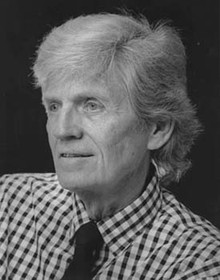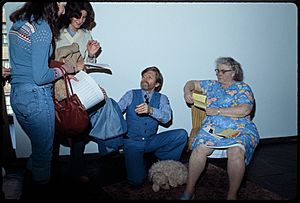Duane Hanson facts for kids
Quick facts for kids
Duane Elwood Hanson
|
|
|---|---|
 |
|
| Born | January 17, 1925 |
| Died | January 6, 1996 (aged 70) |
| Nationality | American |
| Education | BA, 1946, Macalester College, Saint Paul, Minnesota MFA, 1951, Cranbrook Academy of Art, Bloomfield Hills, Michigan |
| Known for | Sculpture |
| Movement | Photorealism, hyperrealism |
Duane Hanson (born January 17, 1925 – died January 6, 1996) was an American artist. He was famous for making very realistic, life-sized sculptures of people. He was born in Minnesota but lived most of his life in South Florida.
Hanson made his sculptures by casting them from real human models. He used different materials like polyester resin, fiberglass, a car body filler called Bondo, and bronze. His amazing sculptures are now in major art museums. These include The Whitney Museum of American Art and The Smithsonian.
Contents
Who was Duane Hanson?
Duane Elwood Hanson was born on January 17, 1925, in Alexandria, Minnesota. He went to Luther College and the University of Washington. He then graduated from Macalester College in 1946.
After teaching art in high school, he continued his own art studies. He earned a Master of Fine Arts degree in 1951. This degree was from the Cranbrook Academy of Art in Bloomfield Hills.
What kind of art did Duane Hanson make?
Around 1966, Duane Hanson started making sculptures of people. He used materials like fiberglass and vinyl. His first famous works showed groups of figures in scenes. Some of these scenes were about tough or violent topics.
For example, his sculpture Race Riot (1969–1971) showed seven figures. It included a white policeman and an African American man. Other early works also showed social issues of the 1960s. These included Riot (1967) and Vietnam Scene (1969).
How did Hanson make his sculptures look so real?
Hanson made these sculptures by casting them from real people. He then painted the figures to make their skin look very realistic. He even added details like veins and small marks. After painting, he dressed the sculptures in real clothes. He often bought these clothes from second-hand stores.
These early works showed strong messages about society. They were like modern versions of 19th-century French Realist artists. Hanson admired artists like Honoré Daumier. Many of Hanson's early sculptures do not exist today. He destroyed them later. He wanted to be known for his more developed style.
What was Hanson's later style like?
Around 1970, Hanson changed his art. He stopped making intense, violent scenes. Instead, he created more subtle but still very vivid works. In that year, he made Supermarket Shopper, Hardhat, and Tourists. Woman Eating was finished in 1971.
These later sculptures were also life-sized figures made of fiberglass. But unlike his earlier works, these were usually single figures or pairs. They were not involved in violent actions. Instead, his figures often looked tired or bored. They seemed to be staring into space, disconnected from their surroundings.
Hanson's later figures often felt like they were in the same space as the viewer. This sometimes led to funny moments. Examples include Reading Man (1977) and Photographer (1978). Hanson sometimes even used his own children as models. This happened in Cheerleader (1988) and Surfer (1987).
In 2018, two of Hanson's sculptures were shown at the Met Breuer museum. The show was called "Like Life." A critic from The New York Times, Roberta Smith, wrote about it. She said the show compared figurative sculptures from different times. Hanson's realistic “Housepainter II” (1984) was displayed. It was next to “Hermes,” an ancient Greek sculpture.
The critic noted that Hanson's sculpture of a black man painting a wall showed something important. It reminded people that ancient marble statues were originally brightly colored. The idea that Classical art was always white is not true.
Where can you see Duane Hanson's art?
Duane Hanson's sculptures have been shown in many places. He had solo exhibitions in Denmark, Germany, and the United States. His art was also displayed in airports. For example, "The Traveler" was at the Orlando International Airport in 1986. "Vendor with a Walkman" was at the Fort Lauderdale - Hollywood International Airport in 1990.
After his death, his works continued to be shown.
- The Saatchi Gallery in London had an exhibition in 1997.
- The Museum of Art in Fort Lauderdale had a big show in 1998. This show traveled to other museums.
- "Duane Hanson: More than Reality" was a show in 2001. It traveled to several European cities.
- The Serpentine Galleries in London, UK, showed his work in 2015.
Museums that own Hanson's sculptures
Many important art museums have Duane Hanson's sculptures in their permanent collections. This means you can often see them there.
- Whitney Museum of American Art, New York, New York
- San Francisco Museum of Modern Art, San Francisco, California
- Corcoran Gallery of Art, Washington, D.C.
- Cranbrook Art Museum, Bloomfield Hills, Michigan
- Flint Institute of Arts, Flint, Michigan
- Hunter Museum of American Art, Chattanooga, Tennessee
- Lowe Art Museum, University of Miami, Coral Gables, Florida
- Milwaukee Art Museum, Milwaukee, Wisconsin
- Museum Ludwig, Cologne Germany
- Nelson-Atkins Museum of Art, Kansas City, Missouri
- Saatchi Gallery, London, England
- Smithsonian American Art Museum, Washington, D.C.
- Toledo Museum of Art, Toledo, Ohio
- Yale University Art Gallery, New Haven, Connecticut
Images for kids
See also
- Hyperrealism (painting) and sculpture
- Photorealism
- Ron Mueck
- George Segal




